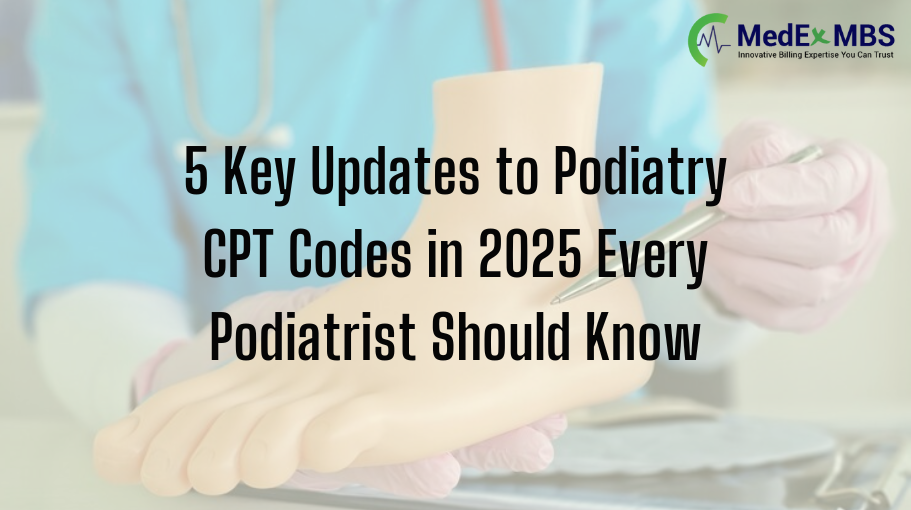5 Key Updates to Podiatry CPT Codes in 2025 Every Podiatrist Should Know

In 2025, the American Medical Association implemented significant modifications to the podiatry CPT codes. Podiatrists are advised against using the previous billing methods, as this may jeopardize their claims, leading to denials, delays, and potential revenue loss. The introduction of new telemedicine codes, the elimination of outdated telephone codes for E/M and wound care, along with remote monitoring, is transforming the documentation process for podiatrists regarding patient care. These coding updates necessitate that podiatrists familiarize themselves with the codes applicable to virtual consultations, wound management, and patient remote monitoring. To avoid extended delays in payment due to erroneous claims, clinics are required to update their billing practices, train their staff, and improve documentation. Whether submitting a claim for a toe amputation (CPT code 28810, CPT 28820), an annual nail debridement (CPT code 11721), or a virtual consultation in podiatry, it is crucial to be aware of these changes; ignorance is not an acceptable stance. This blog will detail the five key changes affecting your standard podiatry CPT codes, elucidate their underlying reasons, and provide guidance on their effective implementation to protect reimbursements and ensure compliance in 2025. New Telemedicine CPT Codes for Foot & Office Visits Podiatrists frequently consult with patients via video or phone. In 2025, new telemedicine codes were introduced for these types of visits. The CPT code set now includes codes 98000–98015 for real-time virtual patient interactions. These new codes enable physicians to bill for video consultations (for new patients: 98000–98003; for returning patients: 98004–98007) and audio-only phone consultations (for new patients: 98008–98011; for returning patients: 98012–98015). Podiatrists are required to utilize these new codes whenever a consultation occurs via live video or phone. This update supersedes the previous approach of merely appending a modifier to a CPT code for a podiatry office visit; now, distinct telemedicine codes must be employed. Deletion of Old Telephone E/M Codes With the introduction of new telemedicine codes, the previous telephone-only evaluation and management codes have been eliminated. The podiatry CPT codes 99441–99443, which were utilized for doctor-patient phone consultations, were officially removed as of January 1, 2025. Consequently, podiatrists are advised against submitting codes 99441–99443 on their claims. Instead, if a phone consultation qualifies as a patient visit, the physician will employ one of the newly established audio-only telemedicine codes (98008–98015) mentioned earlier. This transition ensures that physicians utilize the most current CPT codes for virtual healthcare. New Virtual Check-In Code CPT 98016 Additionally, there is a new code designated for brief patient-initiated check-ins. In 2025, HCPCS G2012, the previous code for a short patient phone check-in, was abolished. It has been succeeded by CPT code 98016. This code encompasses a “brief communication technology-based service” with an established patient. This service involves a 5–10 minute telephone or video call initiated by the patient, during which the physician provides advice or triages the issue. Video is not a requirement for code 98016, and it is applicable only if the patient contacts the doctor more than 7 days after an in-person visit, and it does not result in an immediate follow-up. Podiatrists can now utilize code 98016 in place of the former G2012 for short virtual check-ins. New Skin Cell Suspension Autograft Codes (15011–15018) Podiatrists addressing severe foot wounds, such as significant burns or diabetic ulcers, now have new coding options available in the CPT manual. In 2025, a series of codes for “skin cell suspension autografting” was introduced. These are podiatry CPT codes 15011–15018, which describe an innovative procedure where a small skin sample is transformed into a cell “spray” that can cover a larger wound area. For instance, a small skin sample measuring 1 cm² can be utilized to treat a wound of 80 cm², such as a significant foot ulcer. The codes 15011–15014 pertain to the harvesting and preparation of skin cells, while codes 15015–15018 relate to the application of these cells onto the wound. Podiatrists managing intricate foot wounds are now able to utilize these specific codes rather than relying on more generic graft codes. Updated Digital Health Monitoring Codes (98975–98978) The update for 2025 has also modified the codes associated with remote patient monitoring and digital therapy, which may affect the field of podiatry. The changes made by the AMA to the CPT indicate that CPT 98975 has been amended to encompass “digital therapeutic intervention,” and codes 98976–98978 have been revised to account for the provision of devices or applications utilized in patient monitoring. In straightforward terms, this signifies that there is now formal CPT acknowledgment for digital health instruments (such as home foot monitors or therapeutic applications) employed in patient care. A podiatrist who oversees a patient’s foot health through a digital program or device may apply these codes. These revisions ensure that the CPT system remains aligned with emerging health technologies. Podiatry CPT Codes: 2025 New & Removed Codes Code Range Short Name When to Use Note 99441 / 99443 Deleted telephone E/M codes Do not submit; phone codes removed. Deleted Jan 1, 2025; use 98008–98015 for audio-only visits. 98016 Virtual check-in (brief) Short 5–10 min patient-initiated phone/video check-ins. Replaces HCPCS G2012; use only if not leading to an immediate visit. 15011 / 15018 Skin cell suspension autograft For harvesting, preparing, and spraying skin-cell grafts on large wounds. Use for complex foot wounds (e.g. diabetic ulcers) instead of generic graft codes. 98975 / 98978 Digital health / remote monitoring For monitoring devices or digital therapeutic programs. Use when a device or app is part of patient monitoring or therapy. 11721 Nail debridement (6+ nails) When medically necessary, nail debridement of 6 or more nails is done. Document the nail and medical reason (infection, pain, ADL impact). 28810 / 28820 Toe amputation CPT
